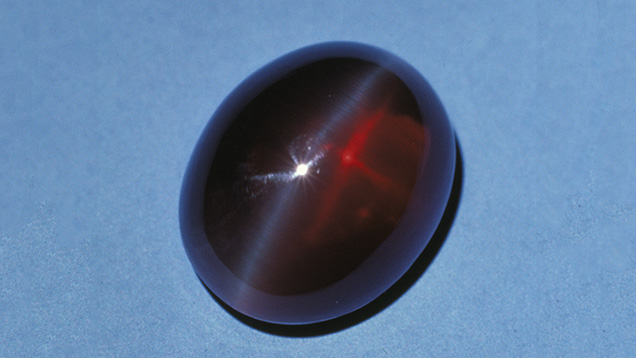Titanium-Bearing Synthetic Alexandrite and Chrysoberyl

This work investigated Czochralski-grown synthetic reddish violet chrysoberyl, transparent alexandrite, and phenomenal alexandrite (both cat’s-eye and star) manufactured by Kyocera. This material entered the marketplace in the late 1980s with the Inamori brand name. The authors noticed unique pleochroism and spectroscopic features in the visible range in all of the samples except the transparent alexandrites—an indication of an unusual chromophore. Specifically, orange coloration influenced the hues observed in incandescent lighting in all three crystallographic directions, and absorption bands at around 500 nm were observed in these samples. It was noted that titanium, an element found in chrysoberyl generally in the form of rutile precipitates, was detectable in elevated concentrations in all of the samples with unusual pleochroism.
As mentioned above, rutile, or TiO2, is the common mineral inclusion that gives rise to asterism and chatoyency in chrysoberyl and other gem minerals, especially in the corundum varieties ruby and sapphire. In natural crystals of virtually all minerals, titanium is found as Ti4+, as Ti3+ is less stable (especially in the presence of iron) and readily oxidizes to Ti4+ (see R.G. Burns, “Intervalence transitions in mixed-valence minerals of iron and titanium,” Annual Review of Earth and Planetary Sciences, Vol. 9, 1981, pp. 345–383). However, titanium-doped synthetic laser crystals of both sapphire and chrysoberyl have been developed with titanium in the trivalent state, as this is the desired oxidation state to produce tunable lasing. In the case of Czochralski-grown titanium sapphire laser crystals, it is well documented that much of the material is grown in a virtually inert atmosphere, and post-growth annealing is conducted in a reducing atmosphere to convert the Ti4+ to Ti3+ (M. Kokta, “Process for enhancing Ti:Al2O3 tunable laser crystal fluorescence by annealing,” US Patent 4,587,035 A, May 6, 1986). Note: This contributor has observed that as-grown titanium sapphire crystals are generally milky and slightly purple in color before annealing. After annealing in a strongly reducing atmosphere such as hydrogen, the corundum crystals become clear and orangy red in color.
An investigation of the literature and comparison to spectroscopic data of the authors’ samples showed that the synthetic reddish violet chrysoberyl crystals and faceted gems and the phenomenal alexandrite samples do appear to have Ti3+ as a chromophore, which leads to the unusual pleochroism observed. In the case of the reddish violet samples, Ti3+ seems to be the predominant chromophore, as only traces of chromium, iron, vanadium, and manganese were detected. The cat’s-eye and star alexandrite samples appear to have a combination of Ti3+ and Cr3+ chromophores (with additional rutile precipitates being responsible for chatoyancy and asterism). The transparent alexandrites, meanwhile, appear to have a combination of Cr3+ and V3+ as chromophores. The detection of trace levels of Ti3+ in chrysoberyl strongly suggests a synthetic origin and possibly further heat treatment in a reducing atmosphere (to form reddish violet samples with predominant Ti3+ contents), and in an oxidizing atmosphere (to form rutile precipitates).



